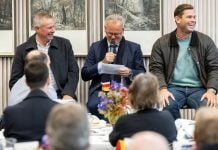Museums matter for the stories they tell us about ourselves. Through a lifetime working in the arts, in both the not-for-profit and public sectors, Hugo Leschen (OM 1978) has come to see the role of the museum as definitive in building our sense of who we are.
“We engage with the objects in a museum because we need to learn from them, reflecting on what has been, and considering what might be,” says Hugo, who has been the CEO at Bendigo’s Golden Dragon Museum since 2020. “By understanding our past, we can learn more about the present, and perhaps even make decisions that lead to a better future.”
Coming full circle in Bendigo
Hugo’s previous roles include Executive Director of Arts and Museums with the Northern Territory Government and Director of Arts Development at Arts New South Wales.
Having also held roles at institutions as diverse as the Melbourne International Film Festival, Victoria State Opera, National Gallery Society of Victoria and Heide Museum of Modern Art, Hugo says his role at the Golden Dragon Museum brings him full circle, even linking back to his Melbourne Grammar days serving on our Library Committee and being involved in the performing arts.
“I started my career at a public art museum, and now I’m serving as CEO of one,” he says. “Museums are judged on the strength of the collections they hold, and the Golden Dragon Museum has without doubt the most important collection of Chinese cultural material in this country.”
Working closely with the Bendigo Chinese Association, which owns much of the museum’s collection, is central to Hugo’s work. “I offer the experience I’ve gained throughout my career to the museum, while drawing on the expertise of those who provide crucial cultural advice.”
Protecting a priceless dragon
The centrepiece of the museum’s collection is a processional dragon named Loong—the oldest intact processional dragon in the world.
“Loong paraded at the celebrations for Australia’s Federation in 1901, and it’s likely he’s the last remaining element of that celebration,” Hugo explains. “The Chinese ritually destroy their processional dragons, and many were also lost in China’s Cultural Revolution, but the Bendigo Chinese community kept their dragons, which means our collection represents an unbroken, 120-year history.”
Even more significantly, these precious dragons are still used by Bendigo’s Chinese community in the city’s annual Easter Fair celebrations.
“All year we look after the dragons, and at Easter the community processes them through the streets for all to see,” Hugo says. “It’s fantastic. Nowhere else can you see a collection so embedded in the local community.”
Hugo is now looking towards the future of the Golden Dragon Museum, working on a redevelopment project that will deliver new gallery spaces and transition the museum to become the National Chinese Museum of Australia.
“It’s important that collecting institutions keep collecting, because when something is lost, it’s lost forever,” Hugo says. “It’s through the arts that we express our history and heritage, along with our ambitions for who we want to become. This drive for creativity and cultural expression is something we can all take strength and hope from.”



